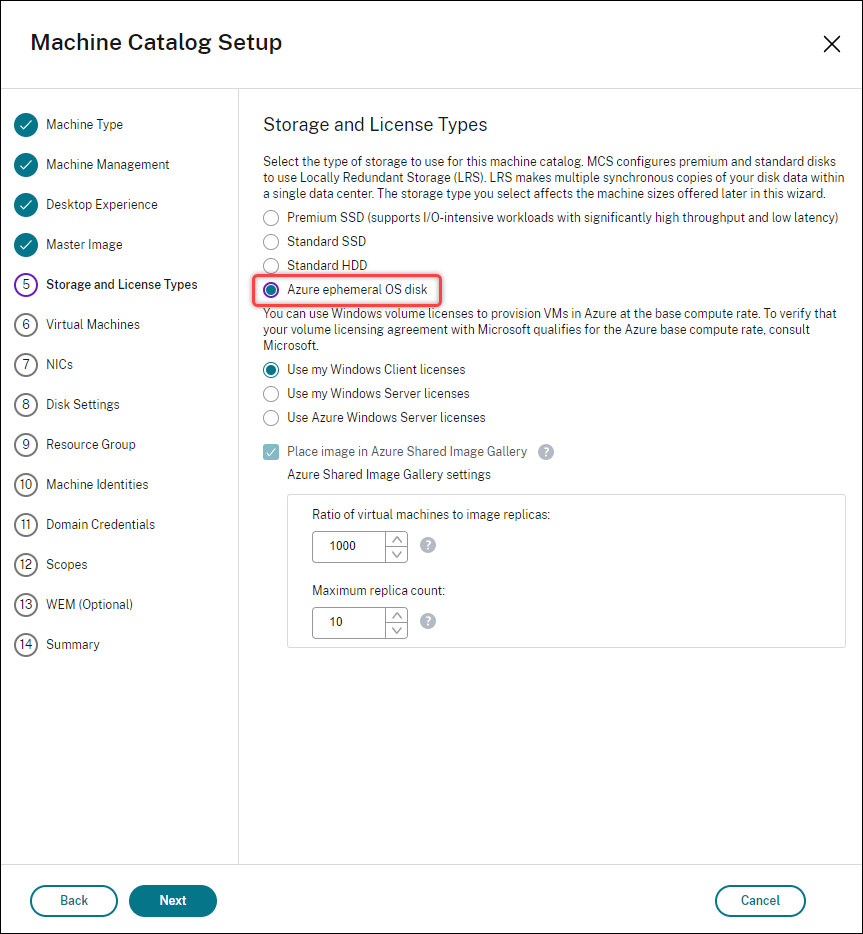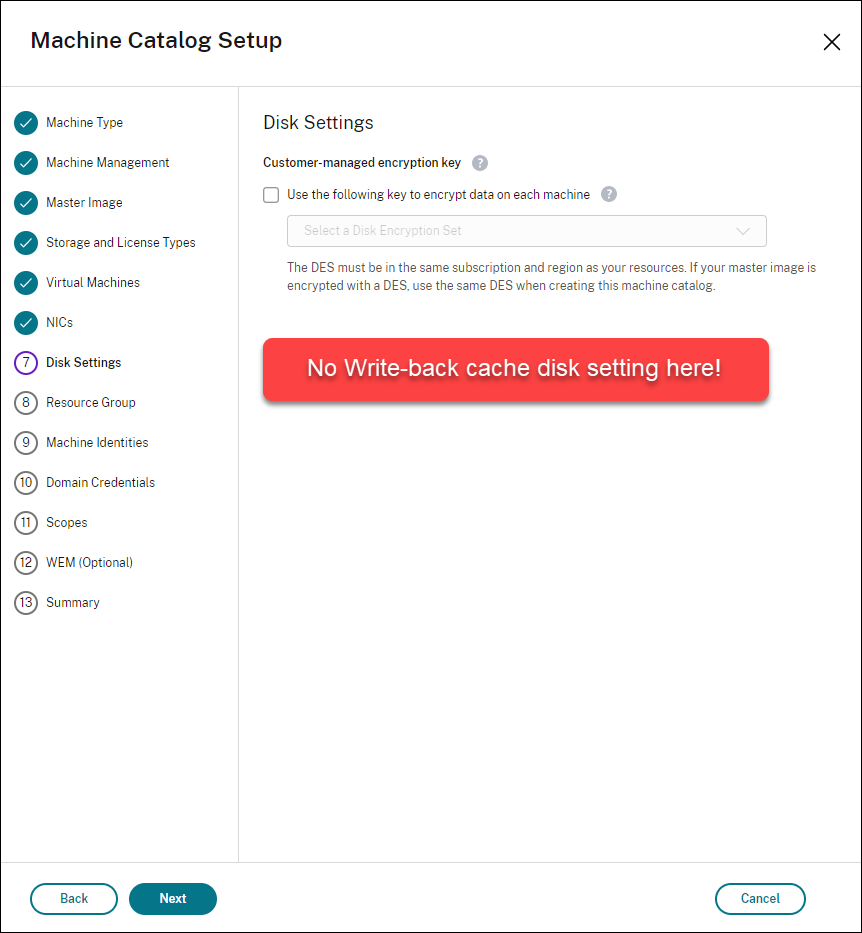Azure ephemeral disks
An Azure ephemeral disk allows you to repurpose the cache disk or temporary disk to store the OS disk for an Azure-enabled virtual machine. This functionality is useful for Azure environments that require a higher performant SSD disk over a standard HDD disk. For information on creating a catalog with an Azure ephemeral disk, see Create a catalog with an Azure ephemeral disk.
Note:
Persistent catalogs do not support ephemeral OS disks.
Ephemeral OS disks require that your provisioning scheme use managed disks and an Azure Compute Gallery. For more information, see Azure shared image gallery.
Store an ephemeral OS temporary disk
You have the option of storing an ephemeral OS disk on the VM temp disk or a resource disk. This functionality enables you to use an ephemeral OS disk with a VM that either doesn’t have a cache, or has insufficient cache. Such VMs have a temp or resource disk to store an ephemeral OS disk, such as Ddv4.
Consider the following:
- An ephemeral disk is stored either in the VM cache disk, or the VMs temporary (resource) disk. The cache disk is preferred over the temporary disk, unless the cache disk is not large enough to hold the contents of the OS disk.
- For updates, a new image that is larger than the cache disk but smaller than the temp disk results in replacing the ephemeral OS disk with the VM’s temp disk.
Create a machine catalog with an Azure ephemeral disk
To provision ephemeral OS disks using New-ProvScheme, consider the following constraints:
- The VM size used for the catalog must support ephemeral OS disks.
- The size of the cache or temporary disk associated with the VM size must be greater than or equal to the size of the OS disk.
- The temporary disk size must be greater than the cache disk size.
Also consider these contraints when:
- Creating the provisioning scheme
- Modifying the provisioning scheme
- Updating the image
To use ephemeral disks, you must set the custom property UseEphemeralOsDisk to true when running New-ProvScheme.
Note:
If the custom property
UseEphemeralOsDiskis set to false or a value is not specified all provisioned VDAs continue to use a provisioned OS disk.
The following is an example set of custom properties to use in the provisioning scheme:
"CustomProperties": [
{
"Name": "UseManagedDisks",
"Value": "true"
},
{
"Name": "StorageType",
"Value": "Standard_LRS"
},
{
"Name": "UseSharedImageGallery",
"Value": "true"
},
{
"Name": "SharedImageGalleryReplicaRatio",
"Value": "40"
},
{
"Name": "SharedImageGalleryReplicaMaximum",
"Value": "10"
},
{
"Name": "LicenseType",
"Value": "Windows_Server"
},
{
"Name": "UseEphemeralOsDisk",
"Value": "true"
}
],
<!--NeedCopy-->
Configure an ephemeral disk for an existing catalog
To configure an Azure ephemeral OS disk for an existing catalog, use the UseEphemeralOsDisk parameter in Set-ProvScheme. Set the value of the UseEphemeralOsDisk parameter to true.
Note:
To use this feature, you must also enable the parameters
UseManagedDisksandUseSharedImageGallery.
For example:
Set-ProvScheme -ProvisioningSchemeName catalog-name -CustomProperties <CustomProperties xmlns="http://schemas.citrix.com/2014/xd/machinecreation" xmlns:xsi="http://www.w3.org/2001/XMLSchema-instance">
<Property xsi:type="StringProperty" Name="UseManagedDisks" Value="true" />
<Property xsi:type="StringProperty" Name="UseSharedImageGallery" Value="true" />
<Property xsi:type="StringProperty" Name="UseEphemeralOsDisk" Value="true" />
</CustomProperties>'
<!--NeedCopy-->
Azure ephemeral disk and Machine Creation Services (MCS) storage optimization (MCS I/O)
Azure ephemeral OS disk and MCS I/O cannot be enabled at the same time.
The important considerations are as follows:
- You cannot create a machine catalog with both ephemeral OS disk and MCS I/O enabled at the same time.
-
In the Machine Catalog Setup wizard, if you select Azure ephemeral OS disk on the Storage and License Types page, you do not get the option for write-back cache disk settings on the Disk Settings page.


- The PowerShell parameters (
UseWriteBackCacheandUseEphemeralOsDisk) set to true inNew-ProvSchemeorSet-ProvSchemefails with proper error message. - For existing machine catalogs created with both features enabled, you can still:
- update a machine catalog.
- add or delete VMs.
- delete a machine catalog.